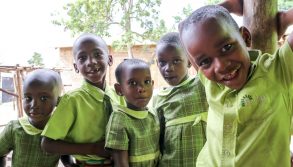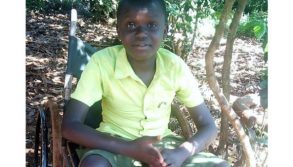Five inspirational stories of disabled children learning
23 July 2018
For millions of children across the world access to a school where they can actually learn is challenging enough. However, in areas that are underprivileged or underserved, an additional hurdle such as disability can prove too difficult to overcome.
Children with disabilities can face multiple forms of exclusion, often limiting their participation in their community. It can also mean they don’t go to school or that they aren’t given the support that they need. Ignorance or a lack of resources, sometimes both, is a real issue; of equal concern is the drive to ensure quality education for children with disabilities — something recognised in the new ‘Charter for Change’ which, it’s hoped, will be the lasting legacy of this week’s Global Disability Summit.
The scale of the Summit’s ambition is huge, and it’s right that we are starting to recognise and talk about access to education for children with disabilities.
Data from Plan International shows:
- Globally, 150 million children live with disabilities; and
- Children with disabilities are 10x less likely to go to school than those without disabilities.
Children with disabilities in the developing world are much more likely to be out-of-school, with an estimated 10% attending and just 5% of these completing primary school. At Bridge, we believe that everyone should have access to quality education, independent of their circumstance. We know that disability is not inability.
Here are five inspiring examples of children from around the developing world, who are pursuing their education despite coping with challenging disabilities.
Adhiambo, Kenya

Madam Risper and Adhiambo.
Adhiambo is a young Kenyan girl whose story shows the transformative impact of inclusive education. When she was younger she developed polio which left her severely physically disabled. Sadly, she was also the victim of sexual violence which resulted in her becoming a parent at a young age. Adhiambo moved to live with her aunt but her aunt struggled to provide for her education. Adhiambo was very unhappy that she wasn’t able to go to school and felt even more isolated.
This all changed when DFID helped her to go to school. Now, Adhiambo is in class everyday and has made huge progress with the help of her teacher, Madam Risper. She dreams of becoming a tailor and opening her own shop. Education has given Adhiambo hope.
She says, of going to school, that: “For the first time, I felt like there was somebody to whom I was an interest […] who took time to ask about my welfare and, who would go out of their way to give me things I had never been given.” Madam Risper, says: “When she started, she was very shy. Now, she is so jovial! I am very proud of her progress.”
Watch this short video to learn more about Adhiambo.
Richard, Ecuador

High up in the hills of Ecuador’s capital city Quito, you’ll find eight-year-old Richard who lives with Marina, his mother and 15-year-old brother, Armando. He has a genetic disorder called osteogenesis imperfecta, also known as brittle bone disease. It means he cannot enjoy a ‘typical’ childhood, he says: “I cannot run or jump or play on the swings. I have bones of glass.” Despite having to be really careful when he’s away from home and with his friends, Richard really enjoys going to school, where he’s top of his class! Education has meant that Richard’s dreams are not limited by his disability. He dreams of taking to the skies one day so that he can see the world.
Learn more about Richard.
Amir, Nepal

Our next story is one of an artist. Amir is 16-years-old from Palung, a remote and ancient market town in southern Nepal. Amir was born without the use of his arms or legs and so he’s adapted to use his mouth to paint pictures and write powerful poems.
Dutch disability charity, the Karuna Foundation discovered Amir in 2015, following the devastating earthquakes in Nepal which left his house unsafe. The Karuna Foundation sponsored him to move to the capital city Kathmandu, where he’s established himself as a Nepalese icon. He’s started to learn English and dreams of travelling to see, learn and paint more.
Amir was homeschooled in Palung, visited by a teacher every day. He says he would sit alone and bottle up his pain, adding: “Rather than talk to other people about my pain, I would talk to these paintings.”
Amir is slowly challenging the false beliefs regarding the potential and capability of children and adults with disabilities by becoming a role model to others. He says: “My teacher says to me to paint what’s in my mind and in my dreams.”
Discover more about Amir and his artwork.
Matha, Cambodia

Matha is 14-years-old and after being born with an oversized skull, she became paralysed as she got older. Her mother says: “We thought Matha could not learn so we left her at home when we were busy with our farm.” This was before UK disability charity, ADD International, paid for Matha to have a tutor at home. Her mother adds: “I started to cry, my little girl is so clever! My tears fell when she told us she wanted to go to school, she had never told us this before.”
Matha went to school to sit exams with other children. She came fourth highest out of 42 pupils and has now started Grade 5. Her mother is fully supportive of Matha’s determination to complete her education, she says: “Since last year, I haven’t needed to push Matha to school in her wheelchair because her schoolmates now help every day!”
Discover more about Matha.
John, Kenya

Madam Nina Wangare and John.
John is 13-years-old from Nakuru, in western Kenya. He’s in Class 8 at Bridge International Academies where he’s working hard to prepare for the primary leaving exam, the KCPE. Success in this exam means he’ll be able to graduate to a secondary school, hopefully of his choice, and maybe even in the USA!
John joined Bridge in 2015 after he faced discrimination, even rejection, from other schools where people couldn’t see past his wheelchair to his talent, intelligence and lively character. He had Polio when he was younger, which means he now has one leg shorter than the other.
The son of semi-literate parents; a housewife and a mjengo guy (labourer) he says: “Bridge has brought a light into my life.” His favourite subject is science, Richard loves to learn how things work and when finishes school, he wants to attend the University of Nairobi to become an engineer.
His teacher Madam Nina Wangare says: “John is a wonderful pupil, the best a teacher would ever want to have; and, despite his unfortunate condition I have – and will always be – there for him. He is like a son to me and I believe he is going to be a great man in the future.”
Read more about Bridge’s results in Kenya.
These are just five of the incredible stories of people with disabilities who are learning against the odds, around the world.
There are millions more.
A school is a place of learning, but it’s much more than that. It’s a network of support and a catalyst for success, academic and social; further, it’s an arena to positively challenge, influence and change the attitudes and beliefs that we hold about ourselves and others.
Children, both disabled and able bodied are still being denied the education they deserve. The latest estimate is 263 million children who are out-of-school and a further 617 million who are in school but not learning. We share the dream — and the belief — of Adhiambo, Richard, Amir, Matha and John that education (and a good school) is transformative; that education allows people to transcend their circumstance and realise their full potential.









